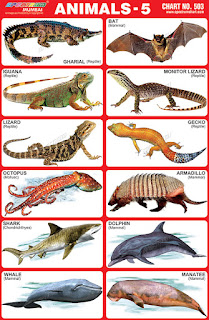Gharial (Reptile) - Gharial
also known as Gavial are found in the fast-flowing rivers in the
northern parts of the Indian subcontinent. Gharial has elongated,
narrow snout filled with 106 to 110 very sharp teeth. Gharial is a
carnivore, they hunt and eat fish. Gharials are listed as critically
endangered species.
Bat (Mammal) - Bats are
large and diverse group of flying mammals. They inhabit all
continents except Antarctica. There are 1100 species of bats. Most
bats are brown or black coloured. Bats are the only mammals capable
of flying. Bats are mostly known for unique, upside down position
they have during sleeping. Bats have a long lifespan. Some species
can live up to 40 years.
Iguana (Reptile) - Land
Iguana is a type of large lizards. It can be found in Mexico,
Central America, Brazil and on Caribbean Islands. Land Iguana has
strong jaws with sharp teeth. They have very long and sharp tail
that is usually half of the body size. Iguana is herbivore, It likes
to eat fruits, leaves and flowers.
Monitor Lizard (Reptile) -
Monitor lizard is large reptile that belongs to the genus Varanus.
There are 78 species of monitor lizard that can be found in Africa,
Asia and Oceania. Monitor lizards inhabit jungles, coastal forests
and areas close to the rivers. Monitor lizard is solitary creature.
It can survive 8 to 30 years in the wild.
Lizard (Reptile) –
Lizards are a widespread group of squamate reptiles, with
approximately over 6,000 species, ranging across all continents
except Antarctica. It is possible for the Lizard to lose their tail
when they feel that they are in danger. The tail will grow back
again.
Gecko (Reptile) - Gecko is
a type of lizard from the family Gekkonidae. They can be found all
over the world, except on the Antarctica. Geckos are often kept as
pets. Geckos are nocturnal creatures. Geckos eat different types of
fruit, flower nectar, insects and worms.
Octopus (Mollusc) - Octopus
is a genus of cephalopod mollusc in the order Octopoda. They have
two eyes and four pairs of arms with suckers. They have a hard beak,
with the mouth at the centre point of the arms.Octopus have no
internal or external skeleton.
Armadillo (Mammal) -
Armadillos are the only mammals whose body is covered with hard
shell. Armadillos can be pinkish, dark-brown, black, red, grey or
yellowish in colour. Their whole body (head, back, legs and tail) is
covered with bony plates.
Shark (Chondrichthyes) -
There are more than 350 different kinds of sharks. Sharks come in
many different shapes and sizes, but most are long and thin, with
powerful jaws. Their teeth are constantly replaced throughout their
lives.
Dolphin (Mammal) - Dolphins
are aquatic marine mammals part of the toothed whales. Dolphins are
from 1.5 to 4 metres long. Although dolphins are widespread, most
species prefer the warmer waters of the tropic zones. Dolphins feed
largely on fish and squid. Dolphins are often regarded as one of
Earth's most intelligent animals.
Whale (Mammal) - Whales are
huge, warm-blooded, air breathing mammals that live in the sea.
There are 79 to 84 different species of whale. Many whales are
toothless. They use a plate of comb-like fibre called baleen to
filter small crustaceans and other creatures from the water.
Manatee (Mammal) - Manatee
is the large aquatic mammal. Manatees resemble to walrus or small
whales, but they are more closely related to elephants. Manatees are
also known as sea cows. They are grey or grey-brown in colour.
Unlike other marine mammals, manatees are strict herbivores.
Manatees live up to 60 years in the wild.


No comments:
Post a Comment